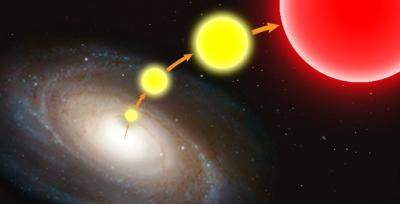Astronomers at Vanderbilt University have managed to identify nearly 700 rogue stars that were likely ejected from the Milky Way galaxy.
As Assistant Professor Kelly Holley-Bockelmann points, it’s actually quite difficult to remove a star from the galaxy. In fact, the two-million-plus mile-per-hour kick requires a close encounter with the supermassive black hole at the galaxy’s core.

Thus far, astronomers have identified 16 of these “hypervelocity” stars. Although traveling fast enough to eventually escape the galaxy’s gravitational grasp, they were discovered while still inside the galaxy.
However, as noted above, Vanderbilt astronomers recently identified a group of more than 675 stars on the outskirts of the Milky Way which they believe are hypervelocity stars ejected from the galactic core. The stars were selected based on their location in intergalactic space between the Milky Way and the nearby Andromeda galaxy, as well as by their peculiar red coloration.
“These stars really stand out,” said Holley-Bockelmann. “They are red giant stars with high metallicity which gives them an unusual color.”
In astronomy and cosmology, “metallicity” is a measure of the proportion of chemical elements other than hydrogen and helium that a star contains. In this case, high metallicity is a signature that indicates an inner galactic origin: Older stars and stars from the galactic fringes tend to have lower metallicities.
The researchers identified these candidates by analyzing the millions of stars catalogued in the Sloan Digital Sky Survey.
“We figured that these rogue stars must be there, outside the galaxy, but no one had ever looked for them,”she explained. ”So we decided to give it a try.”
Indeed, astronomers have found evidence for giant black holes at the centers of many galaxies, estimating that the Milky Way’s central black hole has a mass of four million solar masses. They calculate that the gravitational field surrounding such a supermassive black hole is strong enough to accelerate stars to hypervelocities.
The typical scenario involves a binary pair of stars that get caught in the black hole’s grip. As one of the stars spirals in towards the black hole, its companion is flung outward at a tremendous velocity.
A second scenario occurs during periods when the central black hole is in the process of ingesting a smaller black hole. Any star that ventures too close to the circling pair can also get a hypervelocity kick.
Red giant stars are the end stage in the evolution of small, yellow stars like the Sun. As such, the stars in Holley-Bockelmann’s rogues’ gallery should have been small stars like the Sun when they tangled with the central black hole. As they traveled outward, they continued to age until reaching the red giant stage. Even traveling at hypervelocities, it would take a star about 10 million years to travel from the central hub to the spiral’s edge, 50,000 light years away.
“Studying these rogue stars can provide us with new insights into the history and evolution of our home galaxy,” Holley-Bockelmann added.
The researchers’ next step is determine if any of their candidates are unusually red brown dwarfs instead of red giants. Because brown dwarfs produce a lot less light than red giants, they would have to be much closer to appear equally bright.






